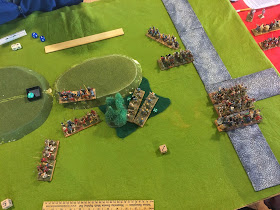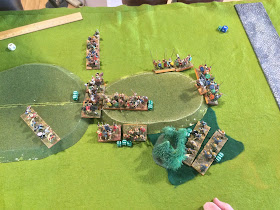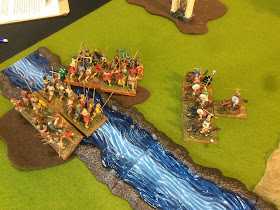I'm back again this week with another test game of Alex's updated Dark Age fast-play rules. The scenario was another out of Neil Thomas' One Hour Wargames book, and featured a force of northern Strathclyde Welsh defending on top of a hill from an attack by their southern cousins.
Alex and I controlled the southern Welsh, who fielded four Warbands unit, one Elite Warband unitone Skirmisher unit, a Leader, and a Banner. Our opponents, Bob and Bob (one being Bob Fanelli who I've talked about on this blog before, and the other being Bob from Alex's last game) had three units of Infantry, two Skirmisher units, one Elite Cavalry unit, a Hero, and a Christian Priest.
The Strathclyde started with two units on top of the hill, one Infantry and one Skirmisher.
On the first turn, the Welsh had three units arrive via the road - two Warbands and the Skirmisher unit. I tried to lure the Infantry on the hill from one side to the other, and then use my Warband's faster movement to throw them off balance. It didn't work, unfortunately, but my Skirmishers did make it into combat with the Strathclyde Skirmishers by the end of the second turn while only taking a few ranged hits.
Since only Skirmishers are allowed into woods in Alex's rules, I thought it would be important to shut down the Strathclyde's relative impunity early on. Thanks to Bob Fanelli's rolls, the slap-fight between the two groups of grown men lasted for most of the game.
On turn three, the Strathclyde received their first reinforcements; two units, their Cavalry and an Infantry unit accompanied by the Christian Priest. These units used the road's movement bonus (+3" if the movement was entirely on the road) to get closer to the fight.
On the fourth turn, the rest of the Welsh army came onto the field, and Alex rushed them up the road. The Strathclyde Cavalry moved to block the Warbands' movement as the relatively slow-moving Infantry unit pushed for the hill, where its defensive bonuses, along with its Shieldwall ability, would grant protection in hand-to-hand combat. The other Strathclyde Infantry unit waited as it watched the two Welsh Warbands move into position.
I wanted a close-up shot of Alex's great work on the cavalry models, which feature a banner formed from an unfortunate Empire soldier from Warhammer Fantasy.
My Welsh Warbands finally engaged with the Strathclyde infantry, but couldn't do much, as any die roll I made was quartered thank's to the Infantry's excellent defensive position. The Strathclyde Cavalry made a few ranged attacks and then retreated, making use of its ability to turn twice while moving (Infantry and Warbands can only move once during a turn, so they must commit to a direction either before or after they advance).
On the turn, the remaining two units of the Strathclyde army arrived, led by their Hero. I position my Warband to flank the Infantry on the hill, and hopefully defeat them before turning to deal with the new enemies. Alex's Warbands, on the right, engaged with the enemy on the hill and began to swing around, chasing after the Strathclyde Cavalry.
Unfortunately for me, the Strathclyde Cavalry charged across the field and up the hill, flanking my flanking Warband! Since any hits caused in the flank are doubled, the Cavalry caused massive damage against my Warband, and prevented me from gaining the same benefits against the infantry on the hill. Not only that, but the newly-arrive Skirmishers were in the perfect position to begin raining arrows down on my Welshmen.
My Warband was quickly overrun, trampled and shot to pieces. However, Alex managed to get not one, but three flank charges in the next couple turns, forcing the Cavalry to disengage and slamming into the sides and rear of the Strathclyde Infantry defending the hill.
A close shot of the battle on the hill, with screaming Welshmen competing with the droning intonations of the Strathclyde Priest.
Alex managed to defeat the two Infantry units on the hill, but the combat presented the Strathclyde Cavalry with another charge into the side of one of Alex's Warbands. Arrows continued to rain down into my own Warband, as the Skirmishers still fought in the woods.
Alex and I were hanging onto a hope of perhaps pulling a victory, but in a single turn our hopes were dashed. Both the Warbands in the middle of the hills were routed, and the Welsh Skirmishers were finally driven from the woods. Now the Strathclyde had a 2:1 numerical advantage over the Welsh.
And that advantage only increased as a hail of arrows saw off one of the two remaining Welsh Warbands!
Suddenly alone and vastly outnumbered, Alex and I decided to admit defeat.
This was definitely a tough scenario for the Welsh. The Strathclyde have a huge advantage in being able to control the hills and the woods from the get-go. The Welsh need to move quickly to make use of a small window of numerical superiority - unfortunately, this didn't happen in our game. However, while I did have to leave, Alex did tell me that Bob and Bob lost with the Welsh as well when they played a second game and switched sides.
I think that Alex's rules are coming along nicely, and I especially like the use of the d5 "averages" dice for movement and combat, as it prevents a single good or bad dice roll from determining whether or not a unit moves when it needs to, or fights well in combat.































